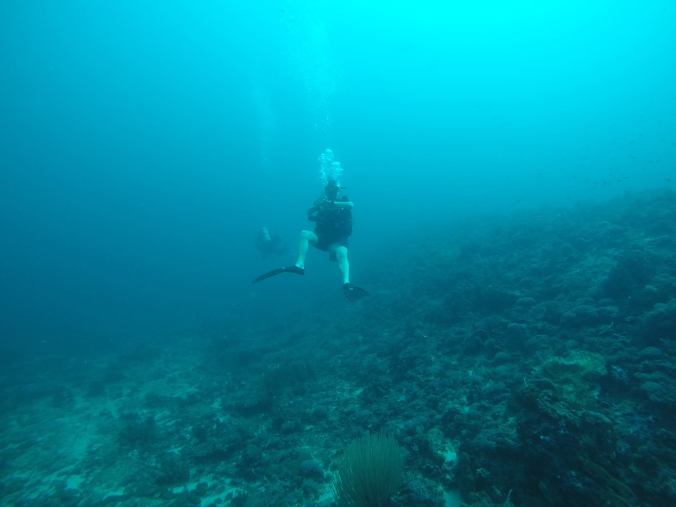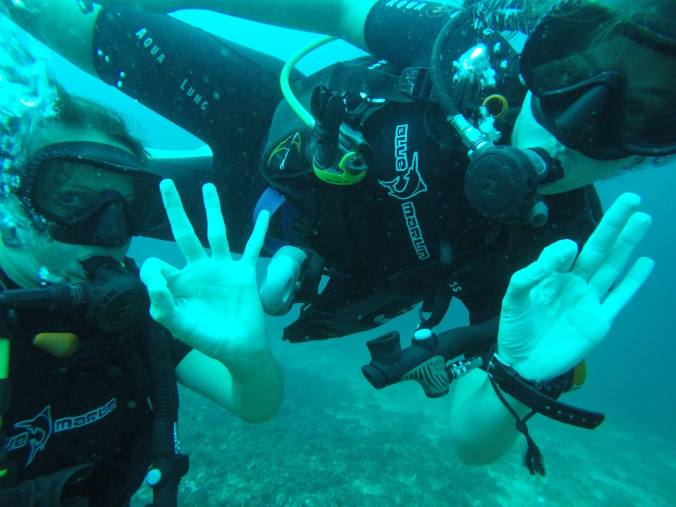Big shout-out and thanks to Gili T’s Blue Marlin Dive for making this post (and all my future under-water adventures) possible! Check out their wordpress blog here.
After watching a rather frightening movie about cave diving, I resolved that diving – of any kind – was something I had no interest in trying. Around the same time, I developed a fear of drowning while sitting on the bottom of a university pool and waiting to be “rescued” during life-guard training. While sitting there in the hazy blue, not knowing when someone would come for me as the seconds ticked and my need for air grew more and more desperate, panic tumbled over me.

The grainy glory days. I’m the one in the swimmies.
I had always loved swimming – so much so that my mom used to call me a “water rat” when I refused to get out of the public pool. I had no problem doing the “rescuing” as a life-guard trainee because I was confident in the water and I was in-control of the situation. But putting myself at the mercy of a rescuer, surrounded by a suddenly hostile environment and not knowing what was going to come next was well outside of my comfort zone.
Fast forward to my trip to Flores last June. After a truly magical two days of waking up to dolphins, swimming with mantas, and splashing around in a kaleidoscope of fish, my good friend Erin told me that she was getting her dive license in January. The prospect of diving brought back cinematic scenes of out-of-air divers drifting away into inky blue caves and frankly, scared the pants off me. And that, precisely, is why I agreed to do it.

Trying to get my under-the-sea legs…channeling my inner-frog perhaps? (Photo cred: Erin B.)
If living in Indonesia has taught me anything, it is the collective human need to overcome our fears. Fear drives distrust, insecurity, bullying, hatred, and traps us in the little boxes we know as our “comfort zones.” Unwilling to dive into the unknown, we fanaticize about all the worst-case-scenarios that come with exiting our fortified boxes. Some days it is so much easier to stay curled up in my bed, my mosquito net shrouding me in the safety of a good book and a long nap. Goodness knows my life would have been “easier” had I just stayed home. But would it have been better? I think not.
I have come to believe that it is a requirement of all members of the human race to stretch into the unknown. Although this need sometimes runs counter to our centuries-old survival instincts, it is this very urge of nature – to risk – that makes us who we are as a species. It sent us to the moon, discovered a cure for polio, and fought for the rights of women and minorities to vote. And lest we think this ability to risk is a privilege afforded to only the most adventurous of souls among us, let me suggest that sometimes the most daring and difficult risks we take are those closest at hand – offering to help a neighbor in need, telling someone we love them, opening ourselves to the people around us.
And thus I found myself strapped to an air tank and plunging into the very thing I feared. I remember one training dive in particular. I had had a bit of trouble with water coming into my regulator (the mouth piece that allows you to breath and therefore stay alive) on the dive prior. It turned out to be no problem, but being the green, literally wet behind the ears diver that I was, it had spooked me. I was keyed up before we even plopped off the boat and into the water, and once we started our decent on this next dive, I looked around and saw…nothing. Just blue haze.
Panic gripped at my chest. As we drifted down, I felt as if I was falling into nothing: the unknown. It’s a weird feeling that everything in my brain – hard-wired for my species’ survival – was trying with all its might to resist. Where do you think you’re going?! Who knows what’s down there? What if your air tank explodes? What if you pass out? What if you discover a new sea monster, and then it eats you?! …but you know what’s up there on the surface? Air. LIFE GIVING AIR. For a few tortured seconds my brain was torn apart in a battle between instinct and will. I HATED not knowing where I was going, not feeling like I was in control.

(Photo cred: Me by way of Erin’s GoPro)
But then I looked at the people around me. I knew that this was the big moment for me – the moment when I would decide to trust my instructors, my buddy, the haze that surrounded me, myself. And you know what? I did. And as I gave myself over to the feeling of falling into the unknown, slowly, shapes and shades emerged – a new environment that I never would have had the privilege of seeing and experiencing, cuttlefish, sharks, sea turtles, and nudibranchs that I never would have known were down there had I allowed my fear to take control.
I was enlightened, empowered, and humbled by the ocean – the unknown becoming known all around me. I have become mesmerized by the underwater world and, while still definitely a newbie, have logged 20 dives (more coming in June!). My fear has been transformed to curiosity, confidence, and an insatiable desire to discover more.

I mean, seriously. Did you know these little nudis were down there? (Photo cred: Mindmaker at English Wikipedia, CC BY-SA 3.0, https://commons.wikipedia.org/w/index.php?curid=10522727)
It seems to me that, more often than not, allowing ourselves to step boldly (or drift along a current) into the unknown never disappoints. Yes, it’s scary. But it is also necessary. Our ability to reach out to one another and experience what is foreign and sometimes uncomfortable, is perhaps more essential now than ever to our species’ survival.
I’ll leave you now with this brief challenge: What scares you? What is calling to you at the same time that it scares your pants off? Is it, perhaps, time for you to face that fear?
Good luck, Godspeed, and happy diving.

























